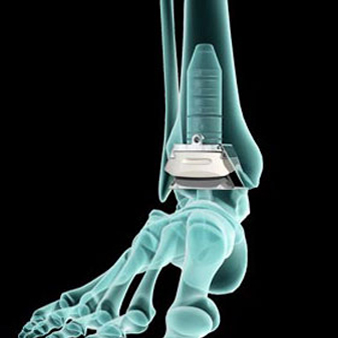Ankle Replacement

Ankle replacement surgery or simply total ankle arthroscopy (TAA) is a surgery usually performed in patients suffering from arthritis in ankle. In this procedure the affected region of lower end of the shin bone called the tibia and the upper portion of the leg bone called the talus are replaced with an artificial implant.Currently many surgeons prefer TAA over the traditional method of arthrodesis.
Arthrodesis or artificial ankylosis has been the traditional method used for the treatment of patients suffering from ankle arthritis. This method employed the technique of fusion of bones. This method helped the patients to get relief from the pain they suffered, but it did not help in restoration of the ankle movement. However this problem can be overcome by using ankle arthroscopy, as it helps in both pain management and restoration of the ankle movement. Bracing of the ankle and ankle foot orthosis (AFO) are also used as the alternative methods.
The surgery only requires two and half hours of time and a hospitalization period of 1-3days. However, estimated time period of 6 weeks is required for the arm to show some movement. By 12 weeks a patient can resume the activities with the help of physical therapy.
Who should consider an ankle replacement?
The most common reason for considering an ankle replacement surgery is severely damaged ankle joint , whose normal movement of the joint is restricted due to acute pain. Patients with badly broken bones, damaged or torn ankle tissues are the other susceptible groups.Those suffering from rheumatoid arthritis or osteoarthritis are also recommended for this replacement.
What tests are required to confirm the need for the surgery?
The need for a ankle replacement surgery is diagnosed after the physical examination of the ankle joints by the surgeon by assessing the mobility.The surgeon confirms the need for the surgery after the visualization of the X-ray reports. Other imaging techniques such as MRI and CT scan are also utilized for this purpose.
What are the risks involved?
One of the risks involved in this replacement surgery is the ankle weakness. In certain cases , there occurs infection at the site of surgery, which in turn, may lead to the requirement of re-operation. Other risks associated with the surgery are fracture , allergic reaction against the new implant, loosening of the new implants, or dislocation. The formation of the blood clots like in any case of surgery is also a concern.
What would be the average life of the implants?
The average life of the artificial ankle implants ranges from 10-20 years or longer depending on lifestyle of the patient, stress put on the joints and care given.Good routine of physical exercises help in increased life of the implants. However, by the passage of time, the implants tend to loosen up leading to revision surgery.
How beneficial would be the prosthesis ?
After the surgery, with the implanted prosthesis and physical therapy ,one can expect a relief from chronic pain. Most people experience an improvement in their mobility .One can carry out their routine activities like walking with much ease.However care should be taken not the put stress on the affected ankle and to keep the leg elevated while sitting.
Clinic
Address: H-7, 2nd floor, Medinova, Near Danapani Restaurant, Janpath, Shyam Nagar, Jaipur-302019
Call : +91 9413862264, 8696565176
Email : drsssoni@gmail.com
Timing : 5:30PM To 8:00PM (Sunday Closed)
Hospital
Address: Apollo Spectra Hospitals, Jai CLub,
J-2/37, Mahavir Marg, Panch Batti,
C-Scheme, Jaipur, Rajasthan 302001
Call : +91 8696565176
Email : drsssoni@gmail.com


